Marketing Intelligence Report: Primark's Brand Strategy and Analysis
VerifiedAdded on 2019/12/03
|22
|6226
|247
Report
AI Summary
This report provides a comprehensive analysis of Primark's marketing intelligence strategies. It begins with an introduction to marketing intelligence and its key elements, followed by an examination of the customer purchase decision process, including need recognition, information search, evaluation of alternatives, purchase, and post-purchase behavior. The report then delves into the importance of understanding buyer behavior, exploring generic and cultural theories, and identifying social, personal, and psychological factors that influence consumer choices. It further analyzes Primark's branding strategies, corporate image, and customer loyalty, including branding strategies like celebrity endorsements. The report concludes with an overview of marketing research techniques and methods of measuring customer satisfaction, making it a valuable resource for students studying marketing.

MARKETING INTELLIGENCE
Paraphrase This Document
Need a fresh take? Get an instant paraphrase of this document with our AI Paraphraser
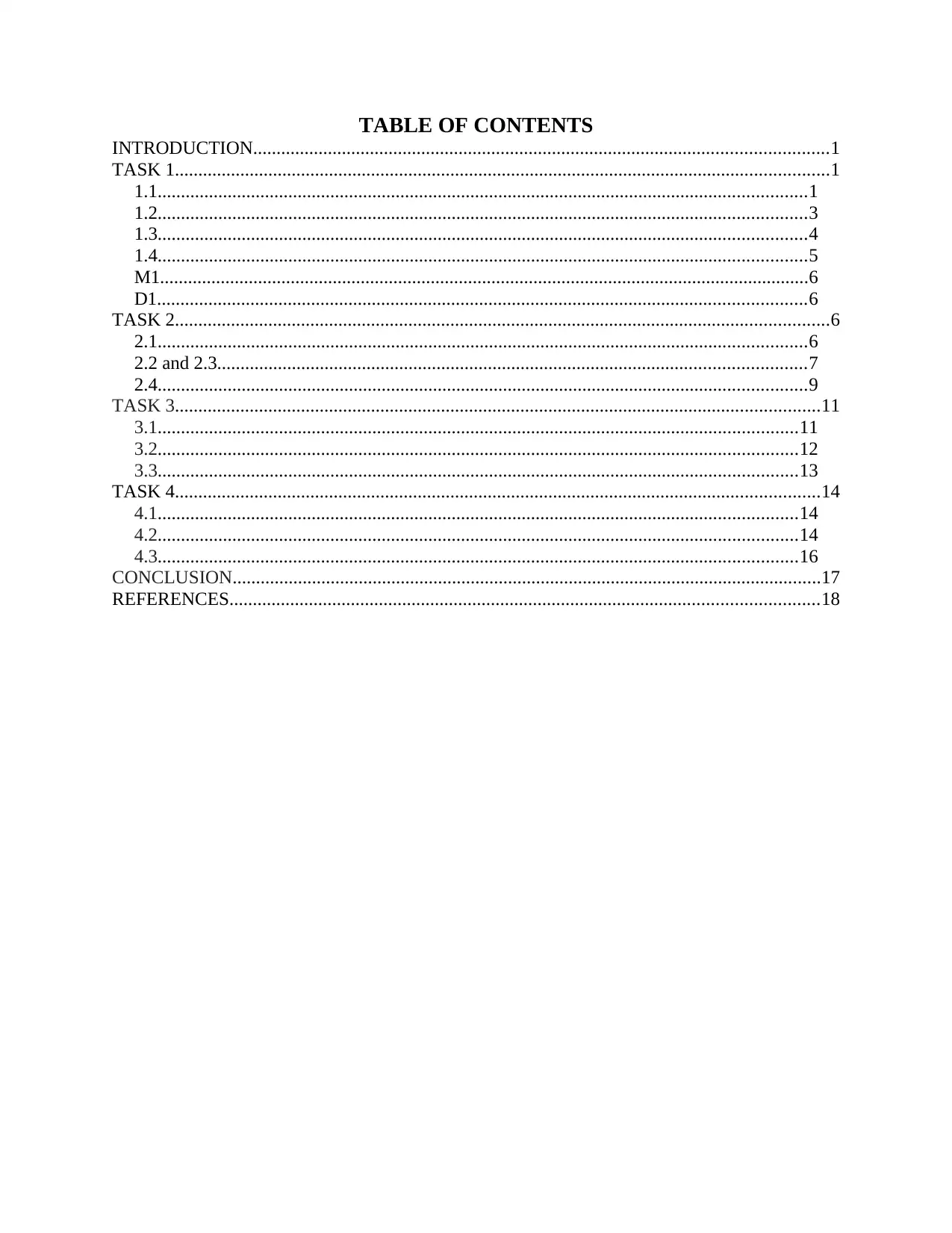
TABLE OF CONTENTS
INTRODUCTION...........................................................................................................................1
TASK 1............................................................................................................................................1
1.1...........................................................................................................................................1
1.2...........................................................................................................................................3
1.3...........................................................................................................................................4
1.4...........................................................................................................................................5
M1...........................................................................................................................................6
D1...........................................................................................................................................6
TASK 2............................................................................................................................................6
2.1...........................................................................................................................................6
2.2 and 2.3..............................................................................................................................7
2.4...........................................................................................................................................9
TASK 3..........................................................................................................................................11
3.1.........................................................................................................................................11
3.2.........................................................................................................................................12
3.3.........................................................................................................................................13
TASK 4..........................................................................................................................................14
4.1.........................................................................................................................................14
4.2.........................................................................................................................................14
4.3.........................................................................................................................................16
CONCLUSION..............................................................................................................................17
REFERENCES..............................................................................................................................18
INTRODUCTION...........................................................................................................................1
TASK 1............................................................................................................................................1
1.1...........................................................................................................................................1
1.2...........................................................................................................................................3
1.3...........................................................................................................................................4
1.4...........................................................................................................................................5
M1...........................................................................................................................................6
D1...........................................................................................................................................6
TASK 2............................................................................................................................................6
2.1...........................................................................................................................................6
2.2 and 2.3..............................................................................................................................7
2.4...........................................................................................................................................9
TASK 3..........................................................................................................................................11
3.1.........................................................................................................................................11
3.2.........................................................................................................................................12
3.3.........................................................................................................................................13
TASK 4..........................................................................................................................................14
4.1.........................................................................................................................................14
4.2.........................................................................................................................................14
4.3.........................................................................................................................................16
CONCLUSION..............................................................................................................................17
REFERENCES..............................................................................................................................18

ILLUSTRATION INDEX
Illustration 1: Purchase decision process.........................................................................................2
Illustration 2: Growth of fashion industry.....................................................................................11
Illustration 3: Market shares of fashion industry...........................................................................12
Illustration 1: Purchase decision process.........................................................................................2
Illustration 2: Growth of fashion industry.....................................................................................11
Illustration 3: Market shares of fashion industry...........................................................................12
⊘ This is a preview!⊘
Do you want full access?
Subscribe today to unlock all pages.

Trusted by 1+ million students worldwide
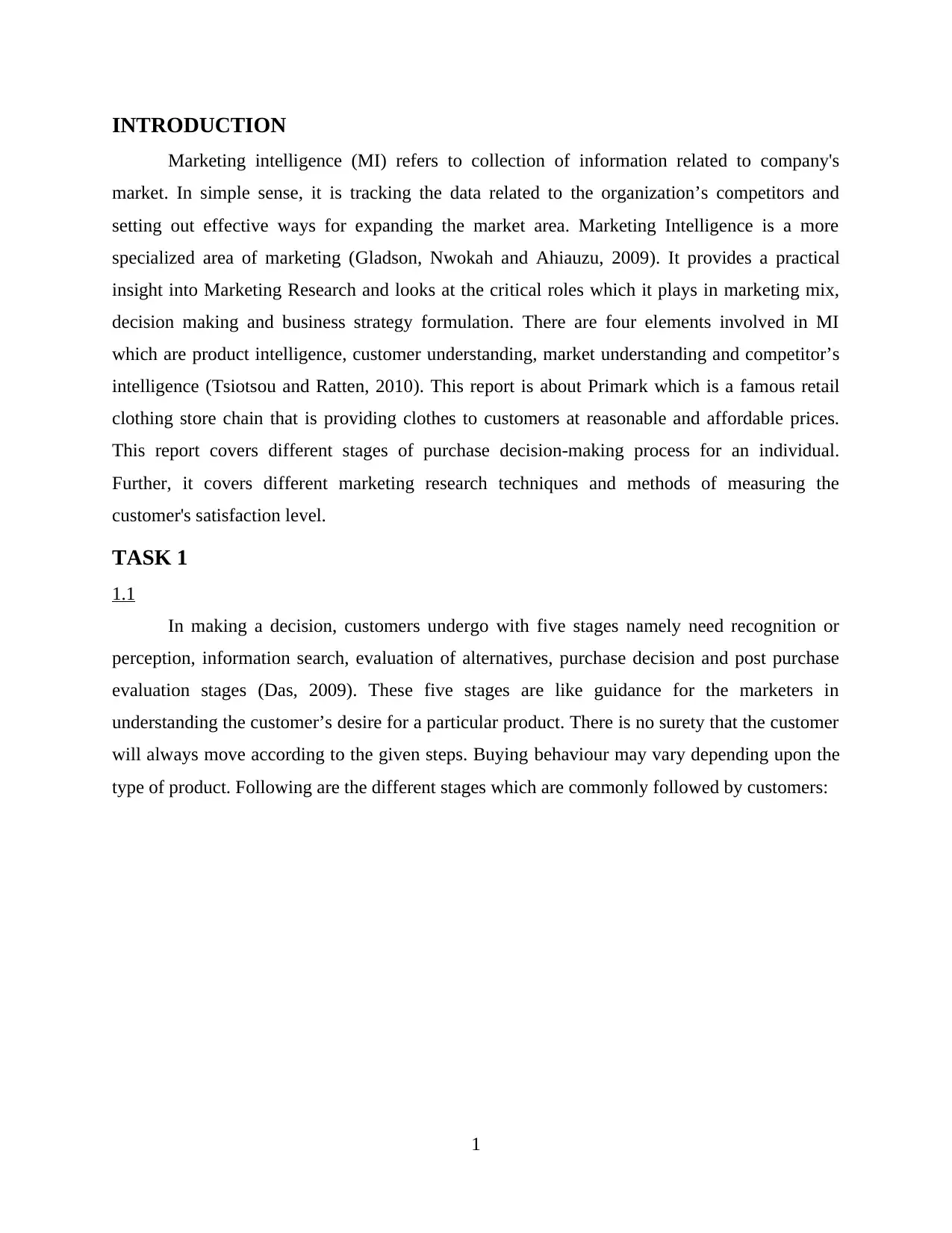
INTRODUCTION
Marketing intelligence (MI) refers to collection of information related to company's
market. In simple sense, it is tracking the data related to the organization’s competitors and
setting out effective ways for expanding the market area. Marketing Intelligence is a more
specialized area of marketing (Gladson, Nwokah and Ahiauzu, 2009). It provides a practical
insight into Marketing Research and looks at the critical roles which it plays in marketing mix,
decision making and business strategy formulation. There are four elements involved in MI
which are product intelligence, customer understanding, market understanding and competitor’s
intelligence (Tsiotsou and Ratten, 2010). This report is about Primark which is a famous retail
clothing store chain that is providing clothes to customers at reasonable and affordable prices.
This report covers different stages of purchase decision-making process for an individual.
Further, it covers different marketing research techniques and methods of measuring the
customer's satisfaction level.
TASK 1
1.1
In making a decision, customers undergo with five stages namely need recognition or
perception, information search, evaluation of alternatives, purchase decision and post purchase
evaluation stages (Das, 2009). These five stages are like guidance for the marketers in
understanding the customer’s desire for a particular product. There is no surety that the customer
will always move according to the given steps. Buying behaviour may vary depending upon the
type of product. Following are the different stages which are commonly followed by customers:
1
Marketing intelligence (MI) refers to collection of information related to company's
market. In simple sense, it is tracking the data related to the organization’s competitors and
setting out effective ways for expanding the market area. Marketing Intelligence is a more
specialized area of marketing (Gladson, Nwokah and Ahiauzu, 2009). It provides a practical
insight into Marketing Research and looks at the critical roles which it plays in marketing mix,
decision making and business strategy formulation. There are four elements involved in MI
which are product intelligence, customer understanding, market understanding and competitor’s
intelligence (Tsiotsou and Ratten, 2010). This report is about Primark which is a famous retail
clothing store chain that is providing clothes to customers at reasonable and affordable prices.
This report covers different stages of purchase decision-making process for an individual.
Further, it covers different marketing research techniques and methods of measuring the
customer's satisfaction level.
TASK 1
1.1
In making a decision, customers undergo with five stages namely need recognition or
perception, information search, evaluation of alternatives, purchase decision and post purchase
evaluation stages (Das, 2009). These five stages are like guidance for the marketers in
understanding the customer’s desire for a particular product. There is no surety that the customer
will always move according to the given steps. Buying behaviour may vary depending upon the
type of product. Following are the different stages which are commonly followed by customers:
1
Paraphrase This Document
Need a fresh take? Get an instant paraphrase of this document with our AI Paraphraser
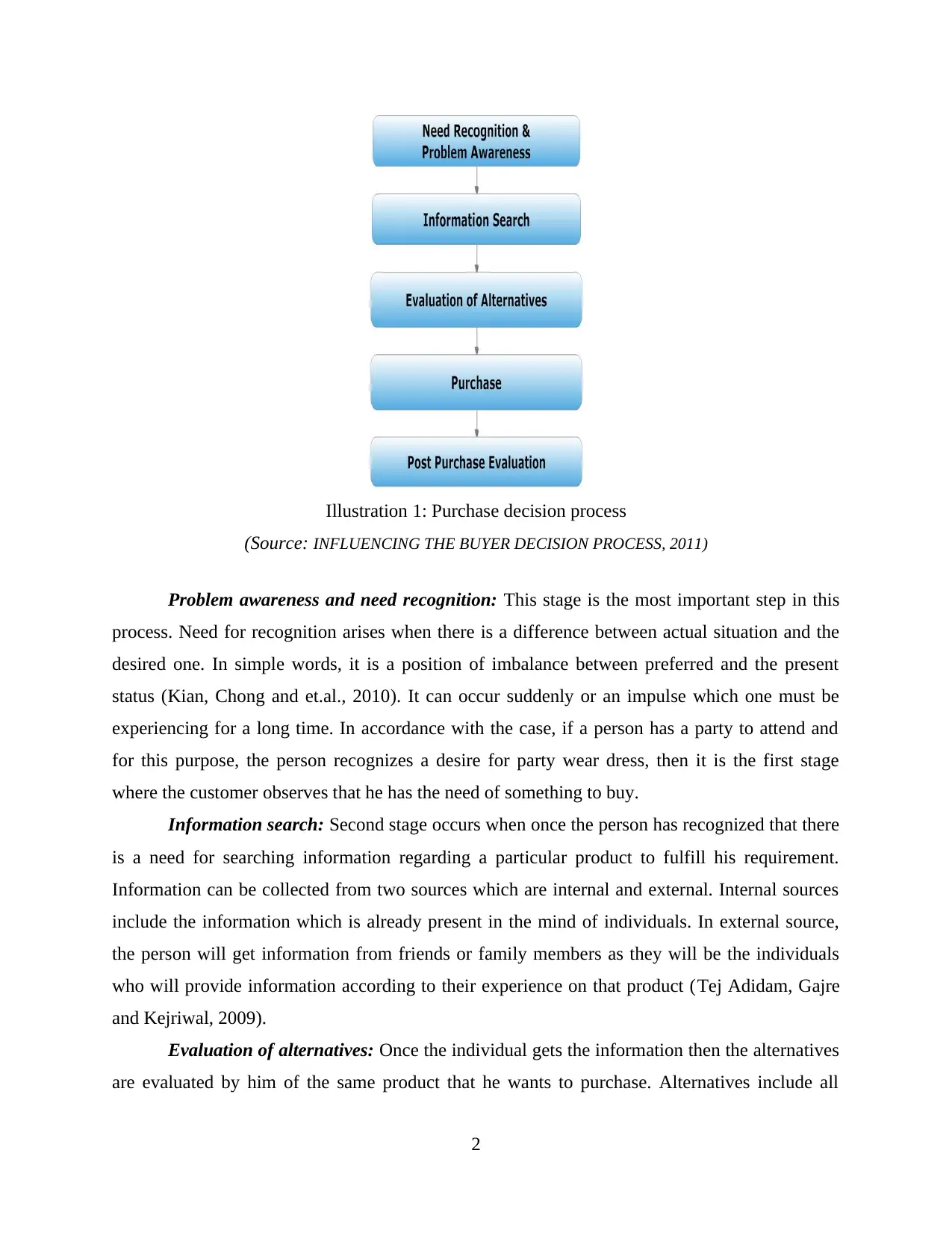
Illustration 1: Purchase decision process
(Source: INFLUENCING THE BUYER DECISION PROCESS, 2011)
Problem awareness and need recognition: This stage is the most important step in this
process. Need for recognition arises when there is a difference between actual situation and the
desired one. In simple words, it is a position of imbalance between preferred and the present
status (Kian, Chong and et.al., 2010). It can occur suddenly or an impulse which one must be
experiencing for a long time. In accordance with the case, if a person has a party to attend and
for this purpose, the person recognizes a desire for party wear dress, then it is the first stage
where the customer observes that he has the need of something to buy.
Information search: Second stage occurs when once the person has recognized that there
is a need for searching information regarding a particular product to fulfill his requirement.
Information can be collected from two sources which are internal and external. Internal sources
include the information which is already present in the mind of individuals. In external source,
the person will get information from friends or family members as they will be the individuals
who will provide information according to their experience on that product (Tej Adidam, Gajre
and Kejriwal, 2009).
Evaluation of alternatives: Once the individual gets the information then the alternatives
are evaluated by him of the same product that he wants to purchase. Alternatives include all
2
(Source: INFLUENCING THE BUYER DECISION PROCESS, 2011)
Problem awareness and need recognition: This stage is the most important step in this
process. Need for recognition arises when there is a difference between actual situation and the
desired one. In simple words, it is a position of imbalance between preferred and the present
status (Kian, Chong and et.al., 2010). It can occur suddenly or an impulse which one must be
experiencing for a long time. In accordance with the case, if a person has a party to attend and
for this purpose, the person recognizes a desire for party wear dress, then it is the first stage
where the customer observes that he has the need of something to buy.
Information search: Second stage occurs when once the person has recognized that there
is a need for searching information regarding a particular product to fulfill his requirement.
Information can be collected from two sources which are internal and external. Internal sources
include the information which is already present in the mind of individuals. In external source,
the person will get information from friends or family members as they will be the individuals
who will provide information according to their experience on that product (Tej Adidam, Gajre
and Kejriwal, 2009).
Evaluation of alternatives: Once the individual gets the information then the alternatives
are evaluated by him of the same product that he wants to purchase. Alternatives include all
2
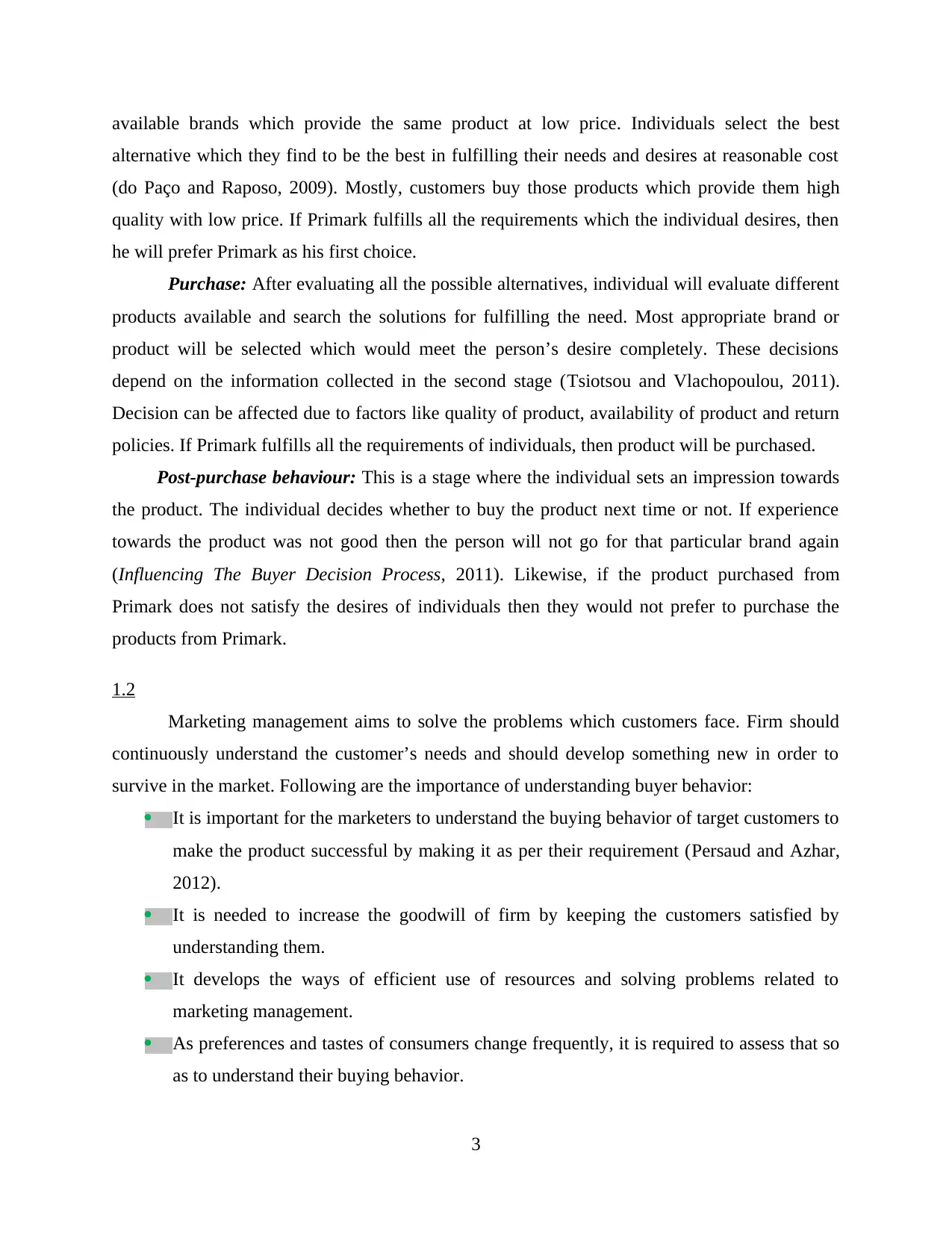
available brands which provide the same product at low price. Individuals select the best
alternative which they find to be the best in fulfilling their needs and desires at reasonable cost
(do Paço and Raposo, 2009). Mostly, customers buy those products which provide them high
quality with low price. If Primark fulfills all the requirements which the individual desires, then
he will prefer Primark as his first choice.
Purchase: After evaluating all the possible alternatives, individual will evaluate different
products available and search the solutions for fulfilling the need. Most appropriate brand or
product will be selected which would meet the person’s desire completely. These decisions
depend on the information collected in the second stage (Tsiotsou and Vlachopoulou, 2011).
Decision can be affected due to factors like quality of product, availability of product and return
policies. If Primark fulfills all the requirements of individuals, then product will be purchased.
Post-purchase behaviour: This is a stage where the individual sets an impression towards
the product. The individual decides whether to buy the product next time or not. If experience
towards the product was not good then the person will not go for that particular brand again
(Influencing The Buyer Decision Process, 2011). Likewise, if the product purchased from
Primark does not satisfy the desires of individuals then they would not prefer to purchase the
products from Primark.
1.2
Marketing management aims to solve the problems which customers face. Firm should
continuously understand the customer’s needs and should develop something new in order to
survive in the market. Following are the importance of understanding buyer behavior:
It is important for the marketers to understand the buying behavior of target customers to
make the product successful by making it as per their requirement (Persaud and Azhar,
2012).
It is needed to increase the goodwill of firm by keeping the customers satisfied by
understanding them.
It develops the ways of efficient use of resources and solving problems related to
marketing management.
As preferences and tastes of consumers change frequently, it is required to assess that so
as to understand their buying behavior.
3
alternative which they find to be the best in fulfilling their needs and desires at reasonable cost
(do Paço and Raposo, 2009). Mostly, customers buy those products which provide them high
quality with low price. If Primark fulfills all the requirements which the individual desires, then
he will prefer Primark as his first choice.
Purchase: After evaluating all the possible alternatives, individual will evaluate different
products available and search the solutions for fulfilling the need. Most appropriate brand or
product will be selected which would meet the person’s desire completely. These decisions
depend on the information collected in the second stage (Tsiotsou and Vlachopoulou, 2011).
Decision can be affected due to factors like quality of product, availability of product and return
policies. If Primark fulfills all the requirements of individuals, then product will be purchased.
Post-purchase behaviour: This is a stage where the individual sets an impression towards
the product. The individual decides whether to buy the product next time or not. If experience
towards the product was not good then the person will not go for that particular brand again
(Influencing The Buyer Decision Process, 2011). Likewise, if the product purchased from
Primark does not satisfy the desires of individuals then they would not prefer to purchase the
products from Primark.
1.2
Marketing management aims to solve the problems which customers face. Firm should
continuously understand the customer’s needs and should develop something new in order to
survive in the market. Following are the importance of understanding buyer behavior:
It is important for the marketers to understand the buying behavior of target customers to
make the product successful by making it as per their requirement (Persaud and Azhar,
2012).
It is needed to increase the goodwill of firm by keeping the customers satisfied by
understanding them.
It develops the ways of efficient use of resources and solving problems related to
marketing management.
As preferences and tastes of consumers change frequently, it is required to assess that so
as to understand their buying behavior.
3
⊘ This is a preview!⊘
Do you want full access?
Subscribe today to unlock all pages.

Trusted by 1+ million students worldwide
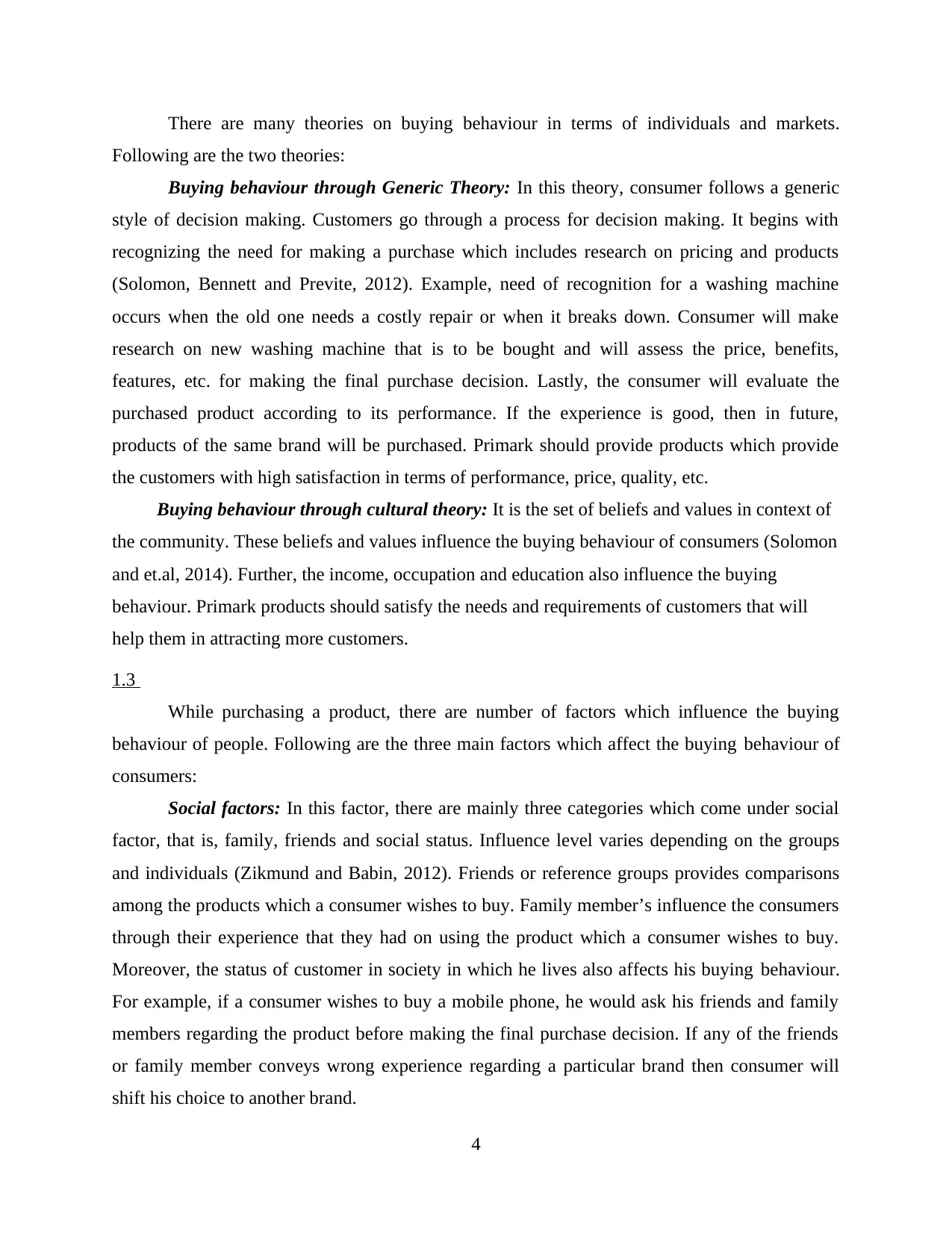
There are many theories on buying behaviour in terms of individuals and markets.
Following are the two theories:
Buying behaviour through Generic Theory: In this theory, consumer follows a generic
style of decision making. Customers go through a process for decision making. It begins with
recognizing the need for making a purchase which includes research on pricing and products
(Solomon, Bennett and Previte, 2012). Example, need of recognition for a washing machine
occurs when the old one needs a costly repair or when it breaks down. Consumer will make
research on new washing machine that is to be bought and will assess the price, benefits,
features, etc. for making the final purchase decision. Lastly, the consumer will evaluate the
purchased product according to its performance. If the experience is good, then in future,
products of the same brand will be purchased. Primark should provide products which provide
the customers with high satisfaction in terms of performance, price, quality, etc.
Buying behaviour through cultural theory: It is the set of beliefs and values in context of
the community. These beliefs and values influence the buying behaviour of consumers (Solomon
and et.al, 2014). Further, the income, occupation and education also influence the buying
behaviour. Primark products should satisfy the needs and requirements of customers that will
help them in attracting more customers.
1.3
While purchasing a product, there are number of factors which influence the buying
behaviour of people. Following are the three main factors which affect the buying behaviour of
consumers:
Social factors: In this factor, there are mainly three categories which come under social
factor, that is, family, friends and social status. Influence level varies depending on the groups
and individuals (Zikmund and Babin, 2012). Friends or reference groups provides comparisons
among the products which a consumer wishes to buy. Family member’s influence the consumers
through their experience that they had on using the product which a consumer wishes to buy.
Moreover, the status of customer in society in which he lives also affects his buying behaviour.
For example, if a consumer wishes to buy a mobile phone, he would ask his friends and family
members regarding the product before making the final purchase decision. If any of the friends
or family member conveys wrong experience regarding a particular brand then consumer will
shift his choice to another brand.
4
Following are the two theories:
Buying behaviour through Generic Theory: In this theory, consumer follows a generic
style of decision making. Customers go through a process for decision making. It begins with
recognizing the need for making a purchase which includes research on pricing and products
(Solomon, Bennett and Previte, 2012). Example, need of recognition for a washing machine
occurs when the old one needs a costly repair or when it breaks down. Consumer will make
research on new washing machine that is to be bought and will assess the price, benefits,
features, etc. for making the final purchase decision. Lastly, the consumer will evaluate the
purchased product according to its performance. If the experience is good, then in future,
products of the same brand will be purchased. Primark should provide products which provide
the customers with high satisfaction in terms of performance, price, quality, etc.
Buying behaviour through cultural theory: It is the set of beliefs and values in context of
the community. These beliefs and values influence the buying behaviour of consumers (Solomon
and et.al, 2014). Further, the income, occupation and education also influence the buying
behaviour. Primark products should satisfy the needs and requirements of customers that will
help them in attracting more customers.
1.3
While purchasing a product, there are number of factors which influence the buying
behaviour of people. Following are the three main factors which affect the buying behaviour of
consumers:
Social factors: In this factor, there are mainly three categories which come under social
factor, that is, family, friends and social status. Influence level varies depending on the groups
and individuals (Zikmund and Babin, 2012). Friends or reference groups provides comparisons
among the products which a consumer wishes to buy. Family member’s influence the consumers
through their experience that they had on using the product which a consumer wishes to buy.
Moreover, the status of customer in society in which he lives also affects his buying behaviour.
For example, if a consumer wishes to buy a mobile phone, he would ask his friends and family
members regarding the product before making the final purchase decision. If any of the friends
or family member conveys wrong experience regarding a particular brand then consumer will
shift his choice to another brand.
4
Paraphrase This Document
Need a fresh take? Get an instant paraphrase of this document with our AI Paraphraser
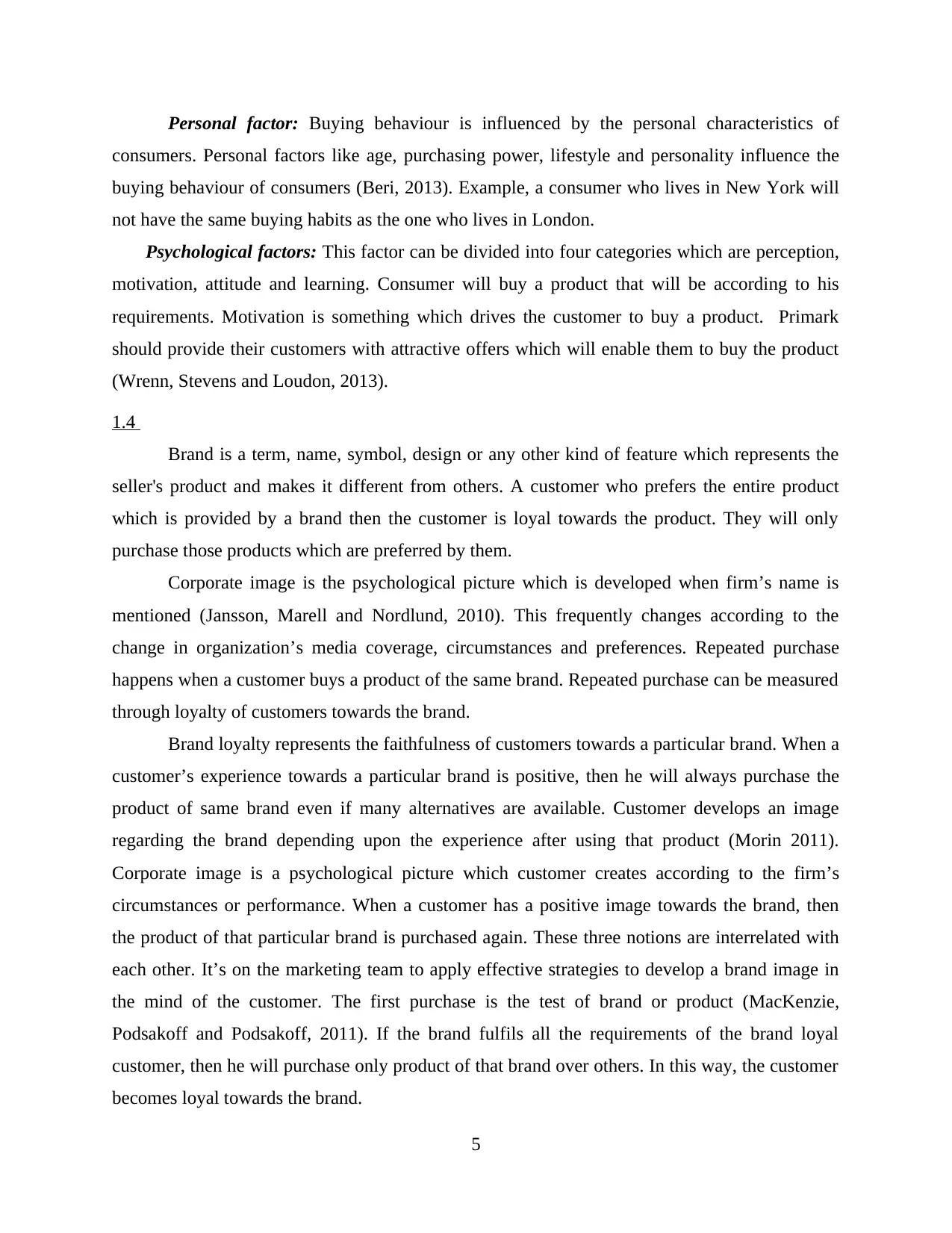
Personal factor: Buying behaviour is influenced by the personal characteristics of
consumers. Personal factors like age, purchasing power, lifestyle and personality influence the
buying behaviour of consumers (Beri, 2013). Example, a consumer who lives in New York will
not have the same buying habits as the one who lives in London.
Psychological factors: This factor can be divided into four categories which are perception,
motivation, attitude and learning. Consumer will buy a product that will be according to his
requirements. Motivation is something which drives the customer to buy a product. Primark
should provide their customers with attractive offers which will enable them to buy the product
(Wrenn, Stevens and Loudon, 2013).
1.4
Brand is a term, name, symbol, design or any other kind of feature which represents the
seller's product and makes it different from others. A customer who prefers the entire product
which is provided by a brand then the customer is loyal towards the product. They will only
purchase those products which are preferred by them.
Corporate image is the psychological picture which is developed when firm’s name is
mentioned (Jansson, Marell and Nordlund, 2010). This frequently changes according to the
change in organization’s media coverage, circumstances and preferences. Repeated purchase
happens when a customer buys a product of the same brand. Repeated purchase can be measured
through loyalty of customers towards the brand.
Brand loyalty represents the faithfulness of customers towards a particular brand. When a
customer’s experience towards a particular brand is positive, then he will always purchase the
product of same brand even if many alternatives are available. Customer develops an image
regarding the brand depending upon the experience after using that product (Morin 2011).
Corporate image is a psychological picture which customer creates according to the firm’s
circumstances or performance. When a customer has a positive image towards the brand, then
the product of that particular brand is purchased again. These three notions are interrelated with
each other. It’s on the marketing team to apply effective strategies to develop a brand image in
the mind of the customer. The first purchase is the test of brand or product (MacKenzie,
Podsakoff and Podsakoff, 2011). If the brand fulfils all the requirements of the brand loyal
customer, then he will purchase only product of that brand over others. In this way, the customer
becomes loyal towards the brand.
5
consumers. Personal factors like age, purchasing power, lifestyle and personality influence the
buying behaviour of consumers (Beri, 2013). Example, a consumer who lives in New York will
not have the same buying habits as the one who lives in London.
Psychological factors: This factor can be divided into four categories which are perception,
motivation, attitude and learning. Consumer will buy a product that will be according to his
requirements. Motivation is something which drives the customer to buy a product. Primark
should provide their customers with attractive offers which will enable them to buy the product
(Wrenn, Stevens and Loudon, 2013).
1.4
Brand is a term, name, symbol, design or any other kind of feature which represents the
seller's product and makes it different from others. A customer who prefers the entire product
which is provided by a brand then the customer is loyal towards the product. They will only
purchase those products which are preferred by them.
Corporate image is the psychological picture which is developed when firm’s name is
mentioned (Jansson, Marell and Nordlund, 2010). This frequently changes according to the
change in organization’s media coverage, circumstances and preferences. Repeated purchase
happens when a customer buys a product of the same brand. Repeated purchase can be measured
through loyalty of customers towards the brand.
Brand loyalty represents the faithfulness of customers towards a particular brand. When a
customer’s experience towards a particular brand is positive, then he will always purchase the
product of same brand even if many alternatives are available. Customer develops an image
regarding the brand depending upon the experience after using that product (Morin 2011).
Corporate image is a psychological picture which customer creates according to the firm’s
circumstances or performance. When a customer has a positive image towards the brand, then
the product of that particular brand is purchased again. These three notions are interrelated with
each other. It’s on the marketing team to apply effective strategies to develop a brand image in
the mind of the customer. The first purchase is the test of brand or product (MacKenzie,
Podsakoff and Podsakoff, 2011). If the brand fulfils all the requirements of the brand loyal
customer, then he will purchase only product of that brand over others. In this way, the customer
becomes loyal towards the brand.
5
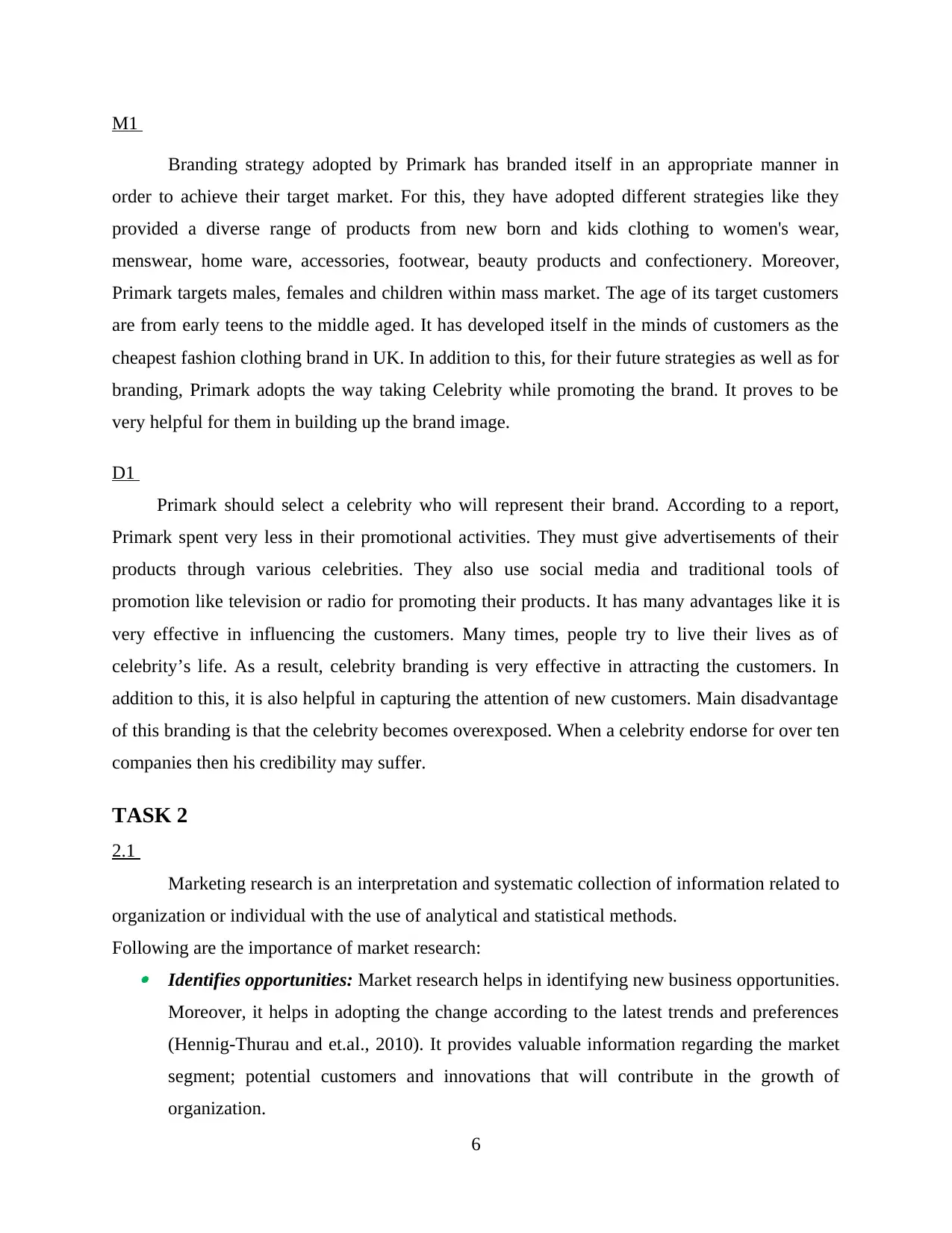
M1
Branding strategy adopted by Primark has branded itself in an appropriate manner in
order to achieve their target market. For this, they have adopted different strategies like they
provided a diverse range of products from new born and kids clothing to women's wear,
menswear, home ware, accessories, footwear, beauty products and confectionery. Moreover,
Primark targets males, females and children within mass market. The age of its target customers
are from early teens to the middle aged. It has developed itself in the minds of customers as the
cheapest fashion clothing brand in UK. In addition to this, for their future strategies as well as for
branding, Primark adopts the way taking Celebrity while promoting the brand. It proves to be
very helpful for them in building up the brand image.
D1
Primark should select a celebrity who will represent their brand. According to a report,
Primark spent very less in their promotional activities. They must give advertisements of their
products through various celebrities. They also use social media and traditional tools of
promotion like television or radio for promoting their products. It has many advantages like it is
very effective in influencing the customers. Many times, people try to live their lives as of
celebrity’s life. As a result, celebrity branding is very effective in attracting the customers. In
addition to this, it is also helpful in capturing the attention of new customers. Main disadvantage
of this branding is that the celebrity becomes overexposed. When a celebrity endorse for over ten
companies then his credibility may suffer.
TASK 2
2.1
Marketing research is an interpretation and systematic collection of information related to
organization or individual with the use of analytical and statistical methods.
Following are the importance of market research: Identifies opportunities: Market research helps in identifying new business opportunities.
Moreover, it helps in adopting the change according to the latest trends and preferences
(Hennig-Thurau and et.al., 2010). It provides valuable information regarding the market
segment; potential customers and innovations that will contribute in the growth of
organization.
6
Branding strategy adopted by Primark has branded itself in an appropriate manner in
order to achieve their target market. For this, they have adopted different strategies like they
provided a diverse range of products from new born and kids clothing to women's wear,
menswear, home ware, accessories, footwear, beauty products and confectionery. Moreover,
Primark targets males, females and children within mass market. The age of its target customers
are from early teens to the middle aged. It has developed itself in the minds of customers as the
cheapest fashion clothing brand in UK. In addition to this, for their future strategies as well as for
branding, Primark adopts the way taking Celebrity while promoting the brand. It proves to be
very helpful for them in building up the brand image.
D1
Primark should select a celebrity who will represent their brand. According to a report,
Primark spent very less in their promotional activities. They must give advertisements of their
products through various celebrities. They also use social media and traditional tools of
promotion like television or radio for promoting their products. It has many advantages like it is
very effective in influencing the customers. Many times, people try to live their lives as of
celebrity’s life. As a result, celebrity branding is very effective in attracting the customers. In
addition to this, it is also helpful in capturing the attention of new customers. Main disadvantage
of this branding is that the celebrity becomes overexposed. When a celebrity endorse for over ten
companies then his credibility may suffer.
TASK 2
2.1
Marketing research is an interpretation and systematic collection of information related to
organization or individual with the use of analytical and statistical methods.
Following are the importance of market research: Identifies opportunities: Market research helps in identifying new business opportunities.
Moreover, it helps in adopting the change according to the latest trends and preferences
(Hennig-Thurau and et.al., 2010). It provides valuable information regarding the market
segment; potential customers and innovations that will contribute in the growth of
organization.
6
⊘ This is a preview!⊘
Do you want full access?
Subscribe today to unlock all pages.

Trusted by 1+ million students worldwide
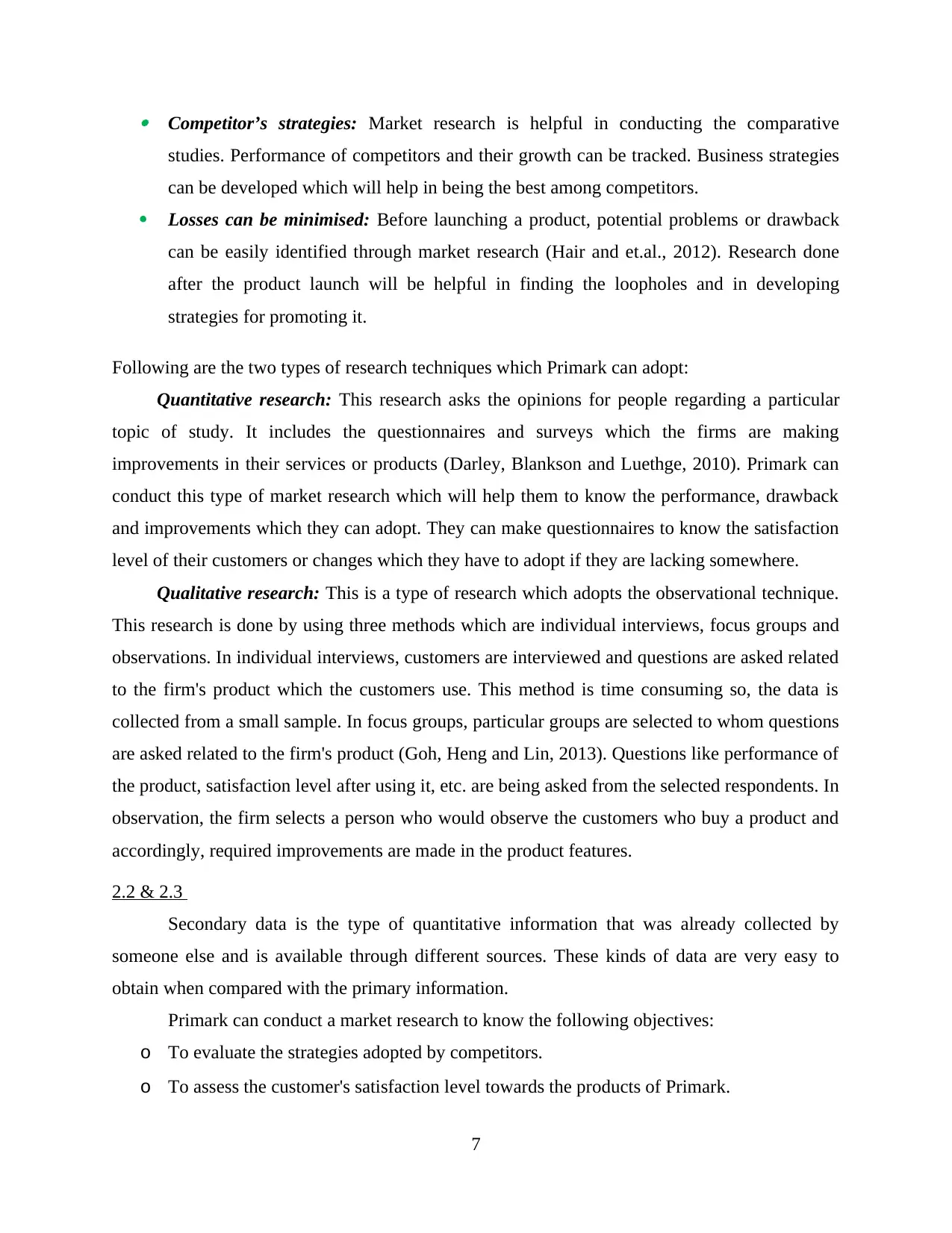
Competitor’s strategies: Market research is helpful in conducting the comparative
studies. Performance of competitors and their growth can be tracked. Business strategies
can be developed which will help in being the best among competitors.
Losses can be minimised: Before launching a product, potential problems or drawback
can be easily identified through market research (Hair and et.al., 2012). Research done
after the product launch will be helpful in finding the loopholes and in developing
strategies for promoting it.
Following are the two types of research techniques which Primark can adopt:
Quantitative research: This research asks the opinions for people regarding a particular
topic of study. It includes the questionnaires and surveys which the firms are making
improvements in their services or products (Darley, Blankson and Luethge, 2010). Primark can
conduct this type of market research which will help them to know the performance, drawback
and improvements which they can adopt. They can make questionnaires to know the satisfaction
level of their customers or changes which they have to adopt if they are lacking somewhere.
Qualitative research: This is a type of research which adopts the observational technique.
This research is done by using three methods which are individual interviews, focus groups and
observations. In individual interviews, customers are interviewed and questions are asked related
to the firm's product which the customers use. This method is time consuming so, the data is
collected from a small sample. In focus groups, particular groups are selected to whom questions
are asked related to the firm's product (Goh, Heng and Lin, 2013). Questions like performance of
the product, satisfaction level after using it, etc. are being asked from the selected respondents. In
observation, the firm selects a person who would observe the customers who buy a product and
accordingly, required improvements are made in the product features.
2.2 & 2.3
Secondary data is the type of quantitative information that was already collected by
someone else and is available through different sources. These kinds of data are very easy to
obtain when compared with the primary information.
Primark can conduct a market research to know the following objectives:
o To evaluate the strategies adopted by competitors.
o To assess the customer's satisfaction level towards the products of Primark.
7
studies. Performance of competitors and their growth can be tracked. Business strategies
can be developed which will help in being the best among competitors.
Losses can be minimised: Before launching a product, potential problems or drawback
can be easily identified through market research (Hair and et.al., 2012). Research done
after the product launch will be helpful in finding the loopholes and in developing
strategies for promoting it.
Following are the two types of research techniques which Primark can adopt:
Quantitative research: This research asks the opinions for people regarding a particular
topic of study. It includes the questionnaires and surveys which the firms are making
improvements in their services or products (Darley, Blankson and Luethge, 2010). Primark can
conduct this type of market research which will help them to know the performance, drawback
and improvements which they can adopt. They can make questionnaires to know the satisfaction
level of their customers or changes which they have to adopt if they are lacking somewhere.
Qualitative research: This is a type of research which adopts the observational technique.
This research is done by using three methods which are individual interviews, focus groups and
observations. In individual interviews, customers are interviewed and questions are asked related
to the firm's product which the customers use. This method is time consuming so, the data is
collected from a small sample. In focus groups, particular groups are selected to whom questions
are asked related to the firm's product (Goh, Heng and Lin, 2013). Questions like performance of
the product, satisfaction level after using it, etc. are being asked from the selected respondents. In
observation, the firm selects a person who would observe the customers who buy a product and
accordingly, required improvements are made in the product features.
2.2 & 2.3
Secondary data is the type of quantitative information that was already collected by
someone else and is available through different sources. These kinds of data are very easy to
obtain when compared with the primary information.
Primark can conduct a market research to know the following objectives:
o To evaluate the strategies adopted by competitors.
o To assess the customer's satisfaction level towards the products of Primark.
7
Paraphrase This Document
Need a fresh take? Get an instant paraphrase of this document with our AI Paraphraser
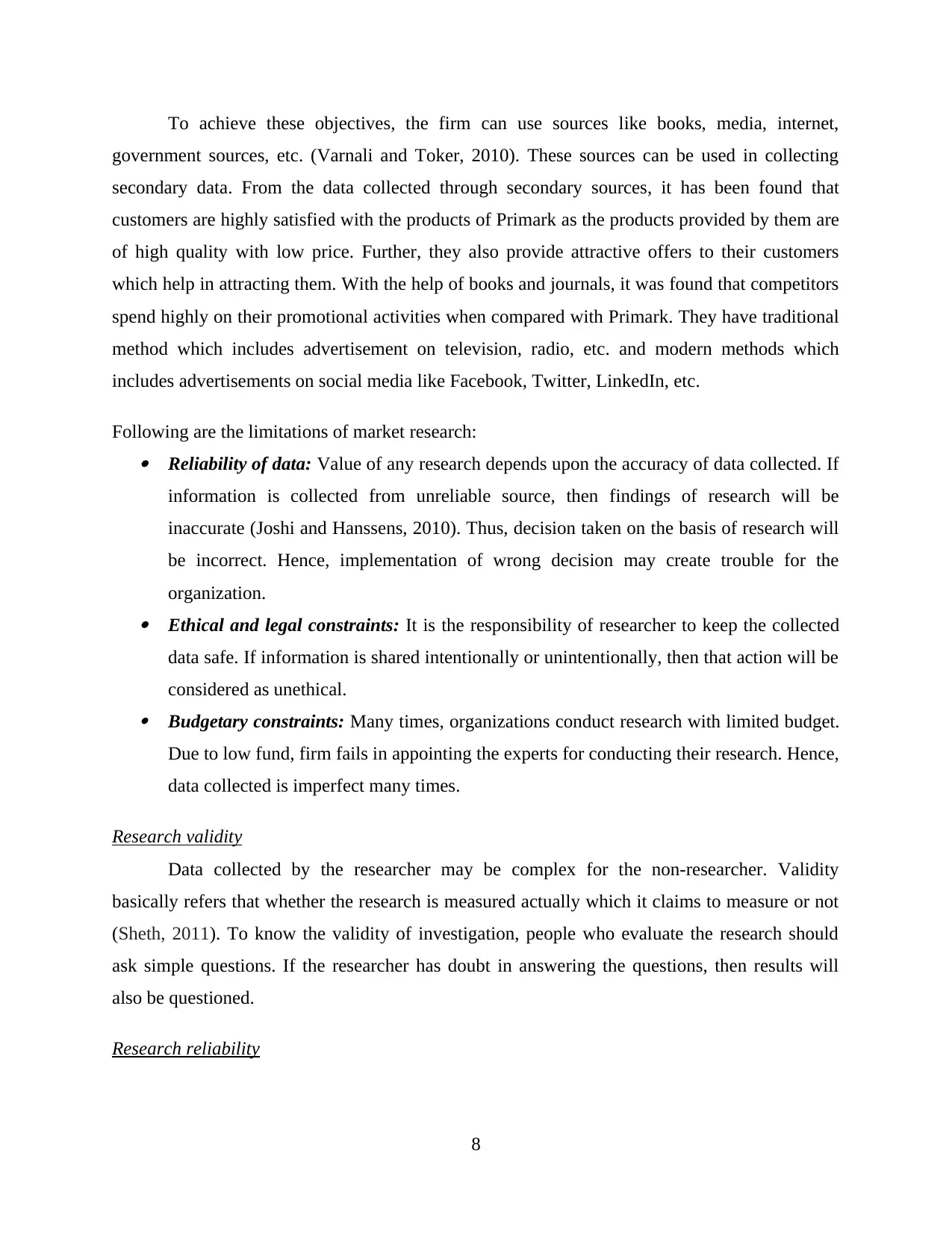
To achieve these objectives, the firm can use sources like books, media, internet,
government sources, etc. (Varnali and Toker, 2010). These sources can be used in collecting
secondary data. From the data collected through secondary sources, it has been found that
customers are highly satisfied with the products of Primark as the products provided by them are
of high quality with low price. Further, they also provide attractive offers to their customers
which help in attracting them. With the help of books and journals, it was found that competitors
spend highly on their promotional activities when compared with Primark. They have traditional
method which includes advertisement on television, radio, etc. and modern methods which
includes advertisements on social media like Facebook, Twitter, LinkedIn, etc.
Following are the limitations of market research: Reliability of data: Value of any research depends upon the accuracy of data collected. If
information is collected from unreliable source, then findings of research will be
inaccurate (Joshi and Hanssens, 2010). Thus, decision taken on the basis of research will
be incorrect. Hence, implementation of wrong decision may create trouble for the
organization. Ethical and legal constraints: It is the responsibility of researcher to keep the collected
data safe. If information is shared intentionally or unintentionally, then that action will be
considered as unethical. Budgetary constraints: Many times, organizations conduct research with limited budget.
Due to low fund, firm fails in appointing the experts for conducting their research. Hence,
data collected is imperfect many times.
Research validity
Data collected by the researcher may be complex for the non-researcher. Validity
basically refers that whether the research is measured actually which it claims to measure or not
(Sheth, 2011). To know the validity of investigation, people who evaluate the research should
ask simple questions. If the researcher has doubt in answering the questions, then results will
also be questioned.
Research reliability
8
government sources, etc. (Varnali and Toker, 2010). These sources can be used in collecting
secondary data. From the data collected through secondary sources, it has been found that
customers are highly satisfied with the products of Primark as the products provided by them are
of high quality with low price. Further, they also provide attractive offers to their customers
which help in attracting them. With the help of books and journals, it was found that competitors
spend highly on their promotional activities when compared with Primark. They have traditional
method which includes advertisement on television, radio, etc. and modern methods which
includes advertisements on social media like Facebook, Twitter, LinkedIn, etc.
Following are the limitations of market research: Reliability of data: Value of any research depends upon the accuracy of data collected. If
information is collected from unreliable source, then findings of research will be
inaccurate (Joshi and Hanssens, 2010). Thus, decision taken on the basis of research will
be incorrect. Hence, implementation of wrong decision may create trouble for the
organization. Ethical and legal constraints: It is the responsibility of researcher to keep the collected
data safe. If information is shared intentionally or unintentionally, then that action will be
considered as unethical. Budgetary constraints: Many times, organizations conduct research with limited budget.
Due to low fund, firm fails in appointing the experts for conducting their research. Hence,
data collected is imperfect many times.
Research validity
Data collected by the researcher may be complex for the non-researcher. Validity
basically refers that whether the research is measured actually which it claims to measure or not
(Sheth, 2011). To know the validity of investigation, people who evaluate the research should
ask simple questions. If the researcher has doubt in answering the questions, then results will
also be questioned.
Research reliability
8
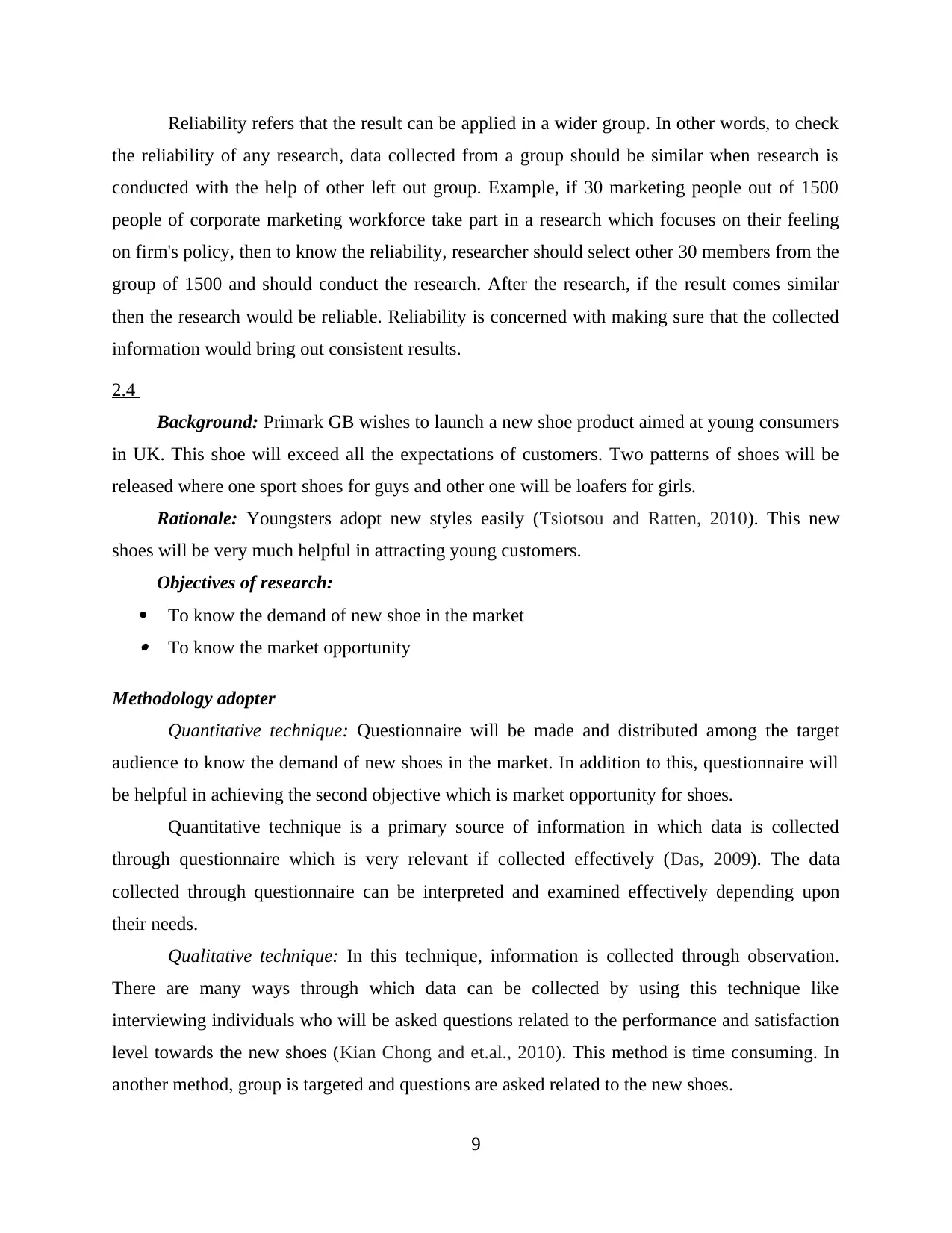
Reliability refers that the result can be applied in a wider group. In other words, to check
the reliability of any research, data collected from a group should be similar when research is
conducted with the help of other left out group. Example, if 30 marketing people out of 1500
people of corporate marketing workforce take part in a research which focuses on their feeling
on firm's policy, then to know the reliability, researcher should select other 30 members from the
group of 1500 and should conduct the research. After the research, if the result comes similar
then the research would be reliable. Reliability is concerned with making sure that the collected
information would bring out consistent results.
2.4
Background: Primark GB wishes to launch a new shoe product aimed at young consumers
in UK. This shoe will exceed all the expectations of customers. Two patterns of shoes will be
released where one sport shoes for guys and other one will be loafers for girls.
Rationale: Youngsters adopt new styles easily (Tsiotsou and Ratten, 2010). This new
shoes will be very much helpful in attracting young customers.
Objectives of research:
To know the demand of new shoe in the market To know the market opportunity
Methodology adopter
Quantitative technique: Questionnaire will be made and distributed among the target
audience to know the demand of new shoes in the market. In addition to this, questionnaire will
be helpful in achieving the second objective which is market opportunity for shoes.
Quantitative technique is a primary source of information in which data is collected
through questionnaire which is very relevant if collected effectively (Das, 2009). The data
collected through questionnaire can be interpreted and examined effectively depending upon
their needs.
Qualitative technique: In this technique, information is collected through observation.
There are many ways through which data can be collected by using this technique like
interviewing individuals who will be asked questions related to the performance and satisfaction
level towards the new shoes (Kian Chong and et.al., 2010). This method is time consuming. In
another method, group is targeted and questions are asked related to the new shoes.
9
the reliability of any research, data collected from a group should be similar when research is
conducted with the help of other left out group. Example, if 30 marketing people out of 1500
people of corporate marketing workforce take part in a research which focuses on their feeling
on firm's policy, then to know the reliability, researcher should select other 30 members from the
group of 1500 and should conduct the research. After the research, if the result comes similar
then the research would be reliable. Reliability is concerned with making sure that the collected
information would bring out consistent results.
2.4
Background: Primark GB wishes to launch a new shoe product aimed at young consumers
in UK. This shoe will exceed all the expectations of customers. Two patterns of shoes will be
released where one sport shoes for guys and other one will be loafers for girls.
Rationale: Youngsters adopt new styles easily (Tsiotsou and Ratten, 2010). This new
shoes will be very much helpful in attracting young customers.
Objectives of research:
To know the demand of new shoe in the market To know the market opportunity
Methodology adopter
Quantitative technique: Questionnaire will be made and distributed among the target
audience to know the demand of new shoes in the market. In addition to this, questionnaire will
be helpful in achieving the second objective which is market opportunity for shoes.
Quantitative technique is a primary source of information in which data is collected
through questionnaire which is very relevant if collected effectively (Das, 2009). The data
collected through questionnaire can be interpreted and examined effectively depending upon
their needs.
Qualitative technique: In this technique, information is collected through observation.
There are many ways through which data can be collected by using this technique like
interviewing individuals who will be asked questions related to the performance and satisfaction
level towards the new shoes (Kian Chong and et.al., 2010). This method is time consuming. In
another method, group is targeted and questions are asked related to the new shoes.
9
⊘ This is a preview!⊘
Do you want full access?
Subscribe today to unlock all pages.

Trusted by 1+ million students worldwide
1 out of 22
Related Documents
Your All-in-One AI-Powered Toolkit for Academic Success.
+13062052269
info@desklib.com
Available 24*7 on WhatsApp / Email
![[object Object]](/_next/static/media/star-bottom.7253800d.svg)
Unlock your academic potential
Copyright © 2020–2025 A2Z Services. All Rights Reserved. Developed and managed by ZUCOL.




